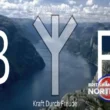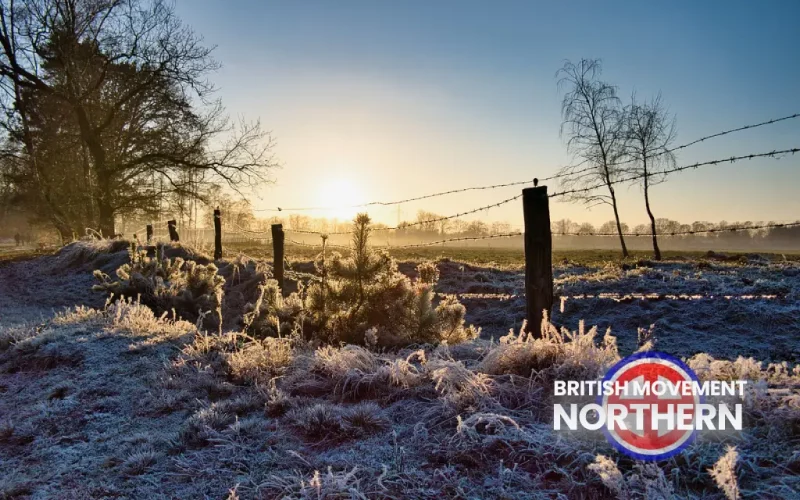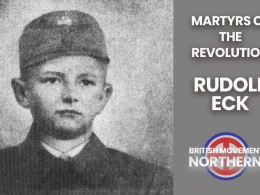An article by Dr. Edward Langford from the archives of Colin Jordan, December 1962.
The Teutonic, Scandinavian and Anglo-Saxon peoples in their early pagan days gave the name Yule to the entire festive season of December and January, and this word is said by some to derive from ‘wheel’, thereby indicating the turning of the seasons, and by others simply to mean ‘rejoicing’.
Always, however, December 25th was its culminating point, and according to Bede, the Anglo-Saxon Church historian, the night of December 24th to 25th was called by the Anglo-Saxons, long before Christianity, Modranecht, or Mother’s Night. As he put it: the very night now so holy to us, was called in their tongue, Modranecht, that is to say Mother’s Night by reason of the ceremonies which is that night-long vigil they performed.
Bede does not, unfortunately, tell us what those ceremonies were, since as a Christian he dismissed them as unimportant, but it is clear to us from our knowledge from other sources that these were connected with the change of the seasons, more explicitly, with the rebirth of the sun. Thus, Christmas, even as Yule, was a nativity festival, and hence in France was called Noel, which means birthday. This night was the occasion of great rejoicing and feasting, and indeed not merely the Anglo-Saxons but all the Teutonic and Scandinavian family made much of this, their most important festival of the year.
As a Nature-Worshipping, or more properly, a Nature-appreciating people, the turning of the wheel of time, of the Sun-wheel at mid-Winter, when the days began to grow longer again instead of shorter, and the minds of farmers, fishermen and Viking-adventurers alike turned to Spring and the reawakening of the world at Easter, was obviously the gayest and happiest of all the great festivals of the seasons.
So, it is said, men made fire in the hills and mountains and waved the Yule brand through the night to honour the reviving sun and to encourage its waxing. There was joy through the promise of stronger and longer light, life’s greatest joy. The Northlander after long weeks of gloominess with great longing for the sunshine again, in mid-Winter, could now be grateful to the sun.
Wherever its beginnings or from whence it came or whatever it meant, Yule is the oldest and highest Feast of the whole North! The archaeologist finds on the Runes and Rune-stones the beginning marked by Horns as was the ending – the Horn being turned upside down accordingly: that is, the drinking and food vessels being empty and the Feasting over.
It is said that from the drinking part of the Feast, the word “Ol” with the prefex “J” or “U” became corrupted into Jul and the English ale (strong beer) and Anglo-Saxon “eale” also bears on this point. In earlier times, the Folk in great brotherhood gathered together bread, beer and meat for a period of two to three weeks Feasting, and each now assembled for the common good did not stint their offerings. Drinking at all Feasts was normal and to all Folk now at this very uncommon Feast in mid-Winter, the root name of “Ol” (Eale) to mark it especially was natural.
The Feast also was known as ‘Julfriede’ or ‘Julred’ (note: A.S. Frith, ‘Eolfrith’ and later English ‘Freeth’). All trouble and strife and enmity along with jealousies and hates were bound to be forgotten during this important period of Feasting. None of the Folk durst break this happy and peaceful gathering or cause trouble of any kind on pain of paying severely for such evil. Friendship, jollity, brotherliness and common happiness ruled everywhere. Tables were decorated, drinking vessels kept filled and the wanderer and stranger were welcomed. Complete joy and happiness which we rarely see today, was the common lot.
In Sweden, much Folklore is used at Yuletide, which today now begins on Christmas Eve and nominally ends on Twelfth Night, or Saint Knut’s Day on the thirteenth of January. Thus the old doggerel – “Trettonde Dag Knut, Dansas Jul ut” or “Sankt Knut, Kor Julen ut”.
Julklappar is the gifts and pranks that the Folk play on each other. Both giver and taker of any kind of Julklappar are in one accord, and months beforehand, all kinds of tricks one concocted for the grand opening of Yuletide! A gold ring is sent inside a thirty pound cake! A large beer cask is delivered to a house and out springs a man who garlands, the house-wife with marzipan confectionery! Eating and drinking! Now are the tables loaded with meats, cheeses, butter, ale and brandywine!
There is jubilation, music, singing and dancing, too. Yule Greeting and Yule Bread and also Yule Straw for the floors are part of the general feasting time. And “Tomtegubbe” was not forgotten at this time. Tomtegubbe is a mysterious dwarf or sprite who keeps his eye on house and home: let him be forgotten and woe betide one afterwards! So he gets a special offering of titbits put outside on plates for his own private participation of Yuletide.
Up to the beginning of the 18th Century, folk would go through forest and valley with blazing firebrands for midnight services at the churches where the floors had been strewn with Yule Straw. This was banned as being a relic of Heathendom. Livestock was especially considered at Yuletide. Horses, hens, sheep and cattle – the lot. Cleaned and cosseted healths drunk to them they were given very special consideration. Besides a common Yule Greeting, there is in Scandinavia, the Yule Ram, which in England and Germany was a Boar.
The Yule-Log, lit from the remains of last year’s log, the candlelit Christmas tree, the holly and mistletoe, in pagan times a sacred branch throughout Europe, (c.f. Frazer’s Golden Bough), the present-giving, the plum pudding and other ancient features are all part of the pagan spirit of Yuletide, and are not Christian in any way in origin or spirit.
The old Yule Festival lasted twenty days in all, and twelve days and twelve nights of Yule fell after “Modranecht” or Christmas Eve. So, today it is still considered ‘bad luck’ to take down the holly, the ivy, the mistletoe, and other more modern Yuletide decorations before the ‘Twelfth Night’ after Christmas, that is to say, until the end of Yule.
How did it happen that the Christian Christmas Day and the Nordic Yule fell on the same day? The Christian Church, as we know, has always been a great imitator or borrower, and one of its greatest causes of success was that whenever possible it took established festivals and customs and called them its own.
The earliest Christian churches were always built on the site of ancient pagan shrines and holy places, to establish a continuity of veneration, and so also festivals such as that of Spring, of the Goddess ‘Eostra’ or Easter, were taken over by the church for itself, and adapted to its own ends. So also with Christmas.
Throughout Europe, because of the Nordic influence amongst the Celts, Greeks and Romans, December 25th was considered holy. It was not, however, Christ’s birthday. What was the church to do? No actual record exists of the true date of the birth of Christ.
Some Christians suggested April 19th as the correct date, others chose May 20th and November 17th, but finally in A.D. 354, that is to say 354 years after the birth of Christ, we hear that December 25th had been adopted as the birthday of Christ.
Many Christians did not allow this to pass without criticism however, and the Syrian church, which claimed January 6th as the birthday of Christ, openly accused Rome of being influenced by idolators, saying that from time immemorial December 25th had been associated with the birth of the sun-god, and had been celebrated by the German tribes as such. But the Syrian church was underestimating the cleverness of the Roman church, for it was by deliberate policies such as this, backed later by military might, that the Roman church became all powerful in Europe. Bede once again confirms that the ancient people of the Anglian nation, began the year on December 25th, when we now celebrate the birth of Christ.
Thus today, despite the influence of Christianity, which teaches us solemnity at Christmas, we still celebrate this ancient festival with laughter and good cheer. With the time-honoured memory of the pagan Boar’s head still fresh in our minds, and still carried to the festive table of a least one ancient college at Oxford, and with much hanging up of stockings by children, and the singing of carols of a seasonal, nature-appreciating character, Yuletide is still the greatest festival of our modern Nordic year.

Resources:
Main Image: by Helga Kattinger from Pixabay.
Bottom Image: by Hans from Pixabay.
The British Movement welcomes articles for possible inclusion on this site from members and supporters across the North of England. Please remember that we have to operate within the laws of this country – we will not include any content that is against the current laws of the United Kingdom. News reports should be topical and be relevant to the regions covered by this website.












